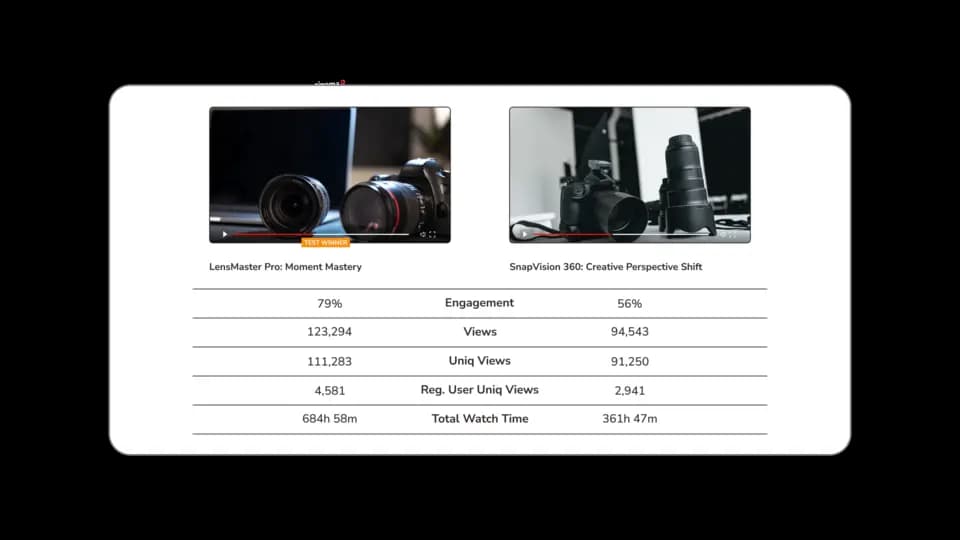Claim the leaderboards with your video
Secure your spot at the top of any engagement chart with compelling videos that grab attention and boost memorability. Level up interactive videos with Cinema8’s gamification tools.
Trusted by leading brands around the world
Track progress, award trophies and badges, engage in friendly competition with Cinema8’s extensive video gamification tools.
Leaderboards and scoring systems
Boost friendly competition among viewers with Cinema8's integrated leaderboards and scoring systems. Test their knowledge with questions and quizzes, award points and showcase progress in leaderboards - as your viewers’ names rise in ranks, enjoy elevated engagement.

Achievement badges and rewards
There can only be one winner in the leaderboard, so make everyone a winner by rewarding learners or loyal customers with badges, custom rewards and coupons. Enhance memorability while incentivising further video engagement and celebrating viewer milestones.

Interactive decision points
Customise each gamification experience with branching pop-ups and interactive decision points that allow viewers to navigate the flow of the video content. Set your viewers out on learning quests, spark curiosity and make sure your content is as memorable as your brand.
Drive action with limitless interactivity
Engage your viewers in diverse ways, using various question formats and polls, badges, rewards, countdowns and timers embedded easily into your videos. Gamify videos while setting out clear learning and product discovery paths, keeping your audiences engaged for longer.

E-learning designers
Boost learner engagement and content retention with gamified quizzes and reward systems.
HR and onboarding teams
Create a culture of belonging and improve training outcomes from day one with gamified onboarding videos.
Video marketers
Deliver truly personalised video marketing campaigns with interactive and gamified elements to enhance ad effectiveness and maximise ROI.
Featured video showcases
Frequently asked
questions (FAQs)
Have another question?
A video gamification tool is software that enables you to embed interactive, game-like features into your video content. These can include elements like quizzes, scoreboards, points, badges, timers, or branching scenarios. The goal is to increase engagement by encouraging active participation, often rewarding viewers for completing tasks or making correct choices.
Some tools allow you to customise how and when these elements appear, and more advanced platforms support performance tracking so you can assess viewer progress or comprehension. Gamified videos can be used in employee training, education, onboarding, and marketing as well as anywhere else where engagement and retention matter.
Cinema8 offers a user-friendly gamification tool where you can add quiz questions, interactive logic, and track user results in real-time. Explore our plans or speak with our team to start creating gamified video experiences.
The most effective use of gamification in video content is when interactive elements are aligned with the viewer’s goals. For example, using quizzes in training videos helps reinforce learning, while time-based challenges in onboarding content can improve information recall. Point scoring, progress indicators, and video branching based on decisions work well in e-learning and compliance content to maintain focus and motivation.
With Cinema8, you can apply these strategies easily whilst personalising each experience. Our tools support interactive elements like badges, CTAs, timers, pop-ups, and branching logic. Choose a plan today and start using video gamification to drive active participation within your content.
You can enhance training videos with gamification elements that promote active learning and sustained attention. These features encourage participation, reinforce key concepts, and help measure understanding.
Common gamification elements include:
- Interactive quizzes to test comprehension during or after segments
- Progress bars to indicate how much of the training is completed
- Points and badges to reward correct answers or completed modules
- Timers for time-bound challenges or assessments
- Decision-based branching to simulate real-life scenarios and choices
- Certificates to acknowledge successful completion
Cinema8 enables you to add all of the above with ease; empowering teams to build motivating and measurable training content that works at scale.
Video gamification improves employee engagement by turning passive content into an interactive experience. When viewers are invited to answer questions, make choices, earn points, or unlock new stages, they become active participants rather than simply spectators. This increased interactivity boosts attention, encourages longer watch times, and improves knowledge retention.
Cinema8 allows you to embed gamified elements directly into your videos. These features help maintain focus and encourage repeat viewing, which is ideal for training, upskilling, and onboarding scenarios.
Explore Cinema8’s plans or reach out to our experts to learn how we can help you create more engaging learning experiences with interactive gamification.
Yes, with the right video platform, you can track viewer progress, points earned, completed actions, and overall achievement across gamified video content. This tracking helps you understand how viewers are interacting with your video, where they succeed or leave the video, and how effectively the gamified elements support learning or engagement.
Cinema8 provides built-in analytics to monitor each viewer’s path, quiz scores, progress through levels and more. These insights let you measure both individual and group performance, making it easier to refine your training or learning strategies. Choose a plan and start gaining deeper insights into your gamified content.
Yes, Cinema8 lets you build fully gamified videos without writing a single line of code. Our drag-and-drop tools allow you to add quizzes, timers, points, and progress indicators directly into your videos using an intuitive interface.
This makes it easy for training managers, instructional designers, or marketers to enhance viewer engagement with game-like elements–without any development experience at all. Whether you're building a compliance module, a product walkthrough, or an interactive learning path, you can gamify it quickly and visually with Cinema8. Get started today or contact our team to learn more about our video gamification tools.
Transform passive viewing into immersive, memorable experiences with Cinema8’s Interaction Designer and gamification features—where every interaction counts towards building lasting engagement.




















